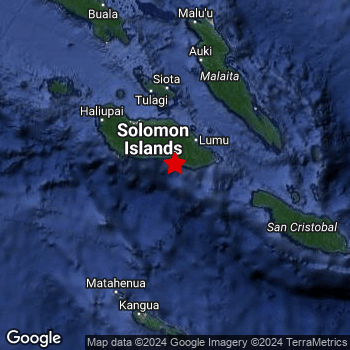In the Solomon Sea 83 kilometer from Honiara, Solomon Islands, a significant M5.1 earthquake occurred deep in the night of Saturday April 27th, 2024.
Felt the earthquake? Share this article: 



Earthquake Summary
This earthquake hit under water in the Solomon Sea, right off the coast of Solomon Islands (10 mi offshore), 83 kilometer south-east of Honiara. The center of this earthquake had a quite shallow depth of 51 km. Shallow earthquakes usually have a larger impact than earthquakes deep in the earth.
| Date and Time: | Apr 27, 2024 03:25 (Guadalcanal Time) - Apr 26, 2024 16:25 Universal Time. |
|---|---|
| Location: | 83 km SE of Honiara, Solomon Islands. Coordinates 10°1'0"S 160°24'60"E. |
| Map: |  Map of area around epicenter. Click to open in Google Maps. |
| Magnitude: | MAG 5.1 Detected by 147 stations. Maximum Error Range ±0.047 . |
| Depth: | 51 km (32 mi) A quite shallow depth. |
| Tsunami Risk: | Low tsunami risk Earthquakes under MAG-6.5 do not usually cause tsunami's. Always stay cautious - More info here. |
Nearby towns and cities
This earthquake may have been felt in Solomon Islands . Located 83 kilometer (52 mi) south-east of the epicenter of this earthquake, Honiara (Honiara, Solomon Islands) is the nearest significant population center.
Overview of nearby places
| Distance | Place |
|---|---|
| 83 km (52 mi) NW from epicenter |
Honiara Honiara, Solomon Islands. |
Aftershocks detected
Before this earthquake struck, 1 smaller foreshock occurred. Nearby this earthquake a foreshock struck 18 hrs earlier. It measured a magnitude of 4.3
Overview of foreshocks and aftershocks
| Classification | Magnitude | When | Where |
|---|---|---|---|
| Foreshock | M 4.3 |
18 hrs earlier Apr 26, 2024 09:45 (Guadalcanal Time) | 84 km (52 mi) ESE from Main Shock. |
| Main Shock This Earthquake |
M 5.1 |
Apr 27, 2024 03:25 (Guadalcanal Time) | - |
More earthquakes coming?
Aftershocks are usually at least 1 order of magnitude less strong than main shocks. The more time passes, the smaller the chance and likely strength of any potential aftershocks.
It's always adviced to be cautious of the risk of a larger shock following any significant earthquake, however this risk is fairly small. There is a roughly 94 percent change that no larger main shock will follow in the days following this earthquake.
Read: How to Stay Safe during an Earthquake (cdc.gov).Earthquakes like this happen often in the region
Earthquakes of this strength are very common in the region. This is the strongest earthquake to hit since April 12th, 2024, when a 5.8 magnitude earthquake hit 70 km (43 mi) further east-southeast. An even stronger magnitude 7.8 earthquake struck on December 8th, 2016.
In total, 134 earthquakes with a magnitude of 5.1 or higher have been registered within 300km (186 mi) of this epicenter in the past 10 years. This comes down to an average of once every 27 days.
Low tsunami risk
Based on early data it appears this earthquake was not strong enough (lower than MAG-6.5) to be likely to cause destructive tsunami's. However this earthquake appeared to have hit at a shallow depth under sea, so stay cautious and monitor advice from local authorities.
Tsunami Risk Factors
| Factor | Under Sea? | MAG-6.5 or stronger? | Shallow depth? |
|---|---|---|---|
| Explanation | Almost all tsunami's are caused by earthquakes with their epicenter under sea or very near the sea. However stay cautious in coastal areas as earthquakes on land may cause landslides into sea, potentially still causing a local tsunami. | Under MAG 6.5: Very unlikely to cause a tsunami. MAG 6.5 to 7.5: Destructive tsunami's do occur, but are uncommon. Likely to observe small sea level changes. MAG 7.6+: Earthquakes with these magnitudes might produce destructive tsunami's. |
Most destructive tsunami's are caused by shallow earthquakes with a depth between 0 and 100km under the surface of the earth. Deeper tsunami's are unlikely to displace to ocean floor. |
| This Earthquake | This earthquake appears to have struck under the sea. | Not this earthquake. This earthquake had a magnitude of 5.1. Earthquakes of this strength are unlikely to trigger a tsunami. |
This earthquake occurred at a depth of of 51 km (32 mi). Earthquakes this shallow could trigger a tsunami. |
Sources
Last updated 06/05/24 17:08 (). This article contains currently available information about the earthquake and is automatically composed. We continue to update this article up to a few days after the earthquake occurred.


